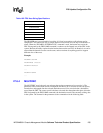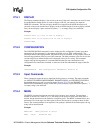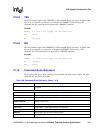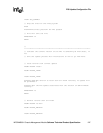
240 MPCMM0001 Chassis Management Module Software Technical Product Specification
FRU Update Configuration File
27.8.6 Input of Data
When taking in data from a file, an environment variable or from standard in, the input type is
always ASCII. If in the configuration file, the type is specified as something other than ASCII, then
it will be read in as ASCII and converted to the correct type. The maximum number of characters
accepted as input does not change based on the input type. For example, if a maximum ASCII
length for a field is 31 characters, then 31 input characters is also the maximum length for BCD,
Binary, and ASCII6 input, therefore using different types does not allow more characters to be
stored, but rather the same number of characters to be stored using fewer bytes.
BCD characters have a few special cases that need to be handled; this is how the utility should
solve them. If only one or two BCD characters are entered, then they will not be accepted because
when translated they take only one byte, and a field length of one byte is not allowed by spec. If an
odd number of BCD characters are input, then they will be pre-appended with a zero in order to
make the length even. Only even length BCD numbers are valid because two numbers are stored in
each BCD byte.
Example 1:
BCD as entered in a FRU file:
99 12 34 56 78
Same BCD value as entered using an environment variable, file or stdin:
9912345678
Example 2:
Odd number of BCD characters entered.
12345
This input will be converted to “012345”
In the case where FRU fields are stored as UNICODE, fewer characters are stored. If 31 ASCII
characters are allowed, then only 15 UNICODE characters will be permitted.
27.9 Display Commands
These commands display text to the user and do nothing else, they are: DISPLAY and
CONFIGURATION. In order to display a blank line, you must display a space enclosed in quotes
(“ ”). An empty string is not sufficient.


















